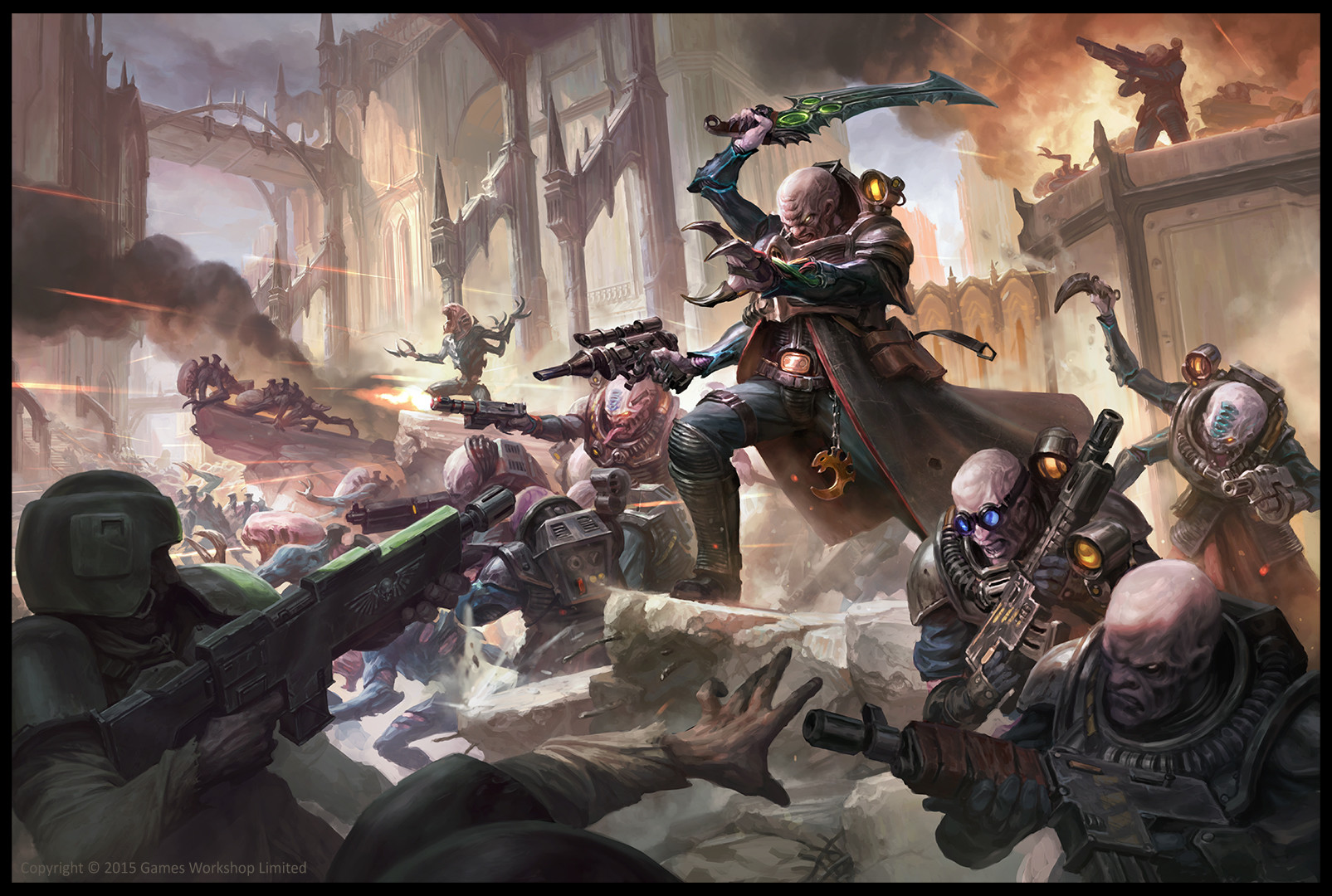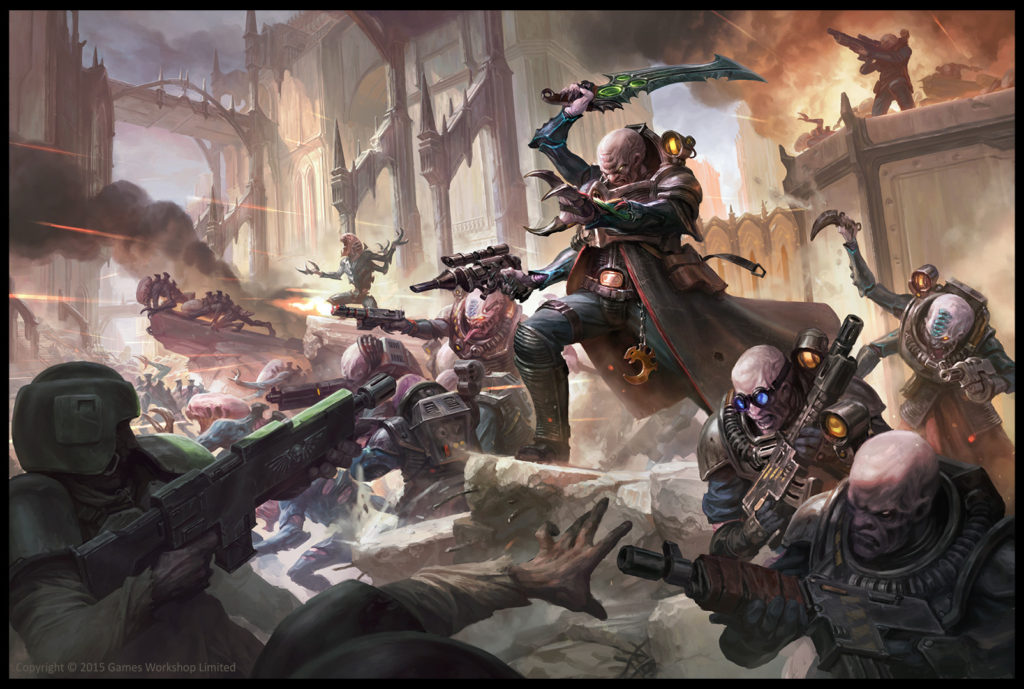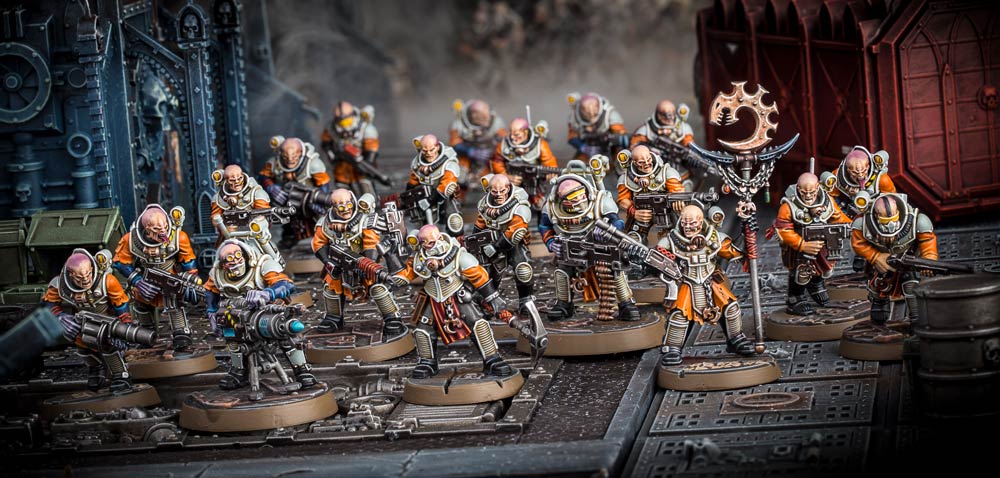Hi everyone, Michael here to take a look at how the new Chapter Approved changes may affect your Genestealer Cults. For more reviews and analyses, check out the Tactics Corner.
The upcoming Chapter approved will have some big impacts on how a number of armies now function in competitive play. The CP changes in particular will have a substantial impact on my GSC tournament army, and I will likely need to completely modify the lists to account for the fewer starting CP. I thought I’d take a look at some of the most substantial impacts to the army.
CP Changes
Players will now start with 6CP for a battle forged list, gaining one CP each player turn, rather than each battle round. In addition, you will no longer get a free Relic and warlord trait, meaning you need to pay a CP for each relic or trait you take in your army.
This is a huge change to army composition and will affect how you want to build your GSC forces. Taking a second detachment in an army is going to be a big expenditure of your precious CP, so most players are going to want to take a single Patrol or Detachment. I was recently running my GSC with a Battalion and a Patrol, so under the new system, taking an extra Patrol will cost a third of your starting CP to begin with.
I will probably try and stick to a single Battalion for my initial test games, limiting me to 6 precious Troops choices. The cost of running a Brigade for GSC is too high, as being forced to take 3 Rockgrinders is going to be too prohibitive.
Objective Secured is an amazing rule, and has been key for winning with the GSC in almost all competitive games. The ability to take cheap Troops choices that can deploy almost anywhere on the board makes GSC great at playing the objective game, and allows them to score a lot of secondary points. I would frequently run 4-5 five-man Acolyte squads for scoring objectives, two bigger squads of 10 Acolytes with combat weapons for the hammer punch in the army, and a couple of squads of Neophytes to sit back and hold objectives and protect characters.
Being limited to only 6 Troops slots means a big shake up of my list construction, unless I spend the 2CP to take a Patrol detachment. This will likely mean weighing into bigger Acolyte squads more heavily, and using other means to protect my characters and backfield objectives. It also makes trading units more risky, as your fragile Troops choices will likely be easily slain by most enemy units.
Where GSC do benefit is the ability to take additional characters without taking up a force organisation slot, allowing you to fit more characters into a single detachment, without using too many precious Elites slots. However, they are also more restricted in taking multiples of the same character in the same detachment. I will miss my second Magus, as he was great for scoring Psychic Interrogation, which has now gotten better.
The changes to warlord traits and Relics is annoying, but not one which will have a massive impact. There are not too many warlord traits that are key for the GSC, so not having one is not going to have a big impact on my list. In addition, you can get two warlord traits for one CP with your Broodcoven stratagem, as long as the Patriarch is your warlord (though he cannot get one of these traits).
When it comes to Relics, I tend to find these more useful for the list. Cranial Inlay for regaining CP points should be more useful, as you will essentially get to roll for double the number of CP in the later turns of the game. I think it will be worth spending a CP or two on Relics, as I have found Cranial Inlay and the Unwilling Orb to be great in my games. Unwilling Orb gives you two Deny rolls that can be used anywhere on the table, so great for potentially blocking key Tyranid or Aeldari powers.
Gaining additional CP as the game goes on will also be great for the GSC. They have some great 1 CP stratagems that can be used to protect your forces or move them around the board, so having an extra CP each battle round should allow you to make the most of them.
Another benefit of being a later codex is that most upgrades are tied into points costs rather than CP upgrades, so you will still be able to do a number of fun tricks with the army.
Core Secondaries
Some more big changes here, so let’s see how they affect the Cults.
For me, the loss of Teleport Homers is a big blow. This was pretty much a guaranteed 15 pts in almost all missions, and really easy to achieve with the GSC, and was more reliable than RND. Genestealer Cults are still really good at getting RND, as they can pop up anywhere on the table in most cases, and the obsec units have an easier time of scoring it. The fragility of the Acolyte and Neophyte squads means it can be tricky scoring RND with the same unit multiple times, as your opponent can easily whittle down or kill a smaller squad and force them to fail the roll to achieve RND.
The change to Engage doesn’t affect GSC too much, similar to RND, you need to be outwith 6″ of another board quarter now. The Ambush ability makes scoring this much easier, as you can just pop out of ambush in a variety of locations. Could be more difficult to achieve as the game proceeds and your forces are being whittled down. However, it only goes off starting strength above 3 now, so your units should be good at getting this unless they are wiped out. I am torn between Engage and Behind Enemy Lines. With likely fewer units in the army, thanks to taking a single detachment, BEL might be harder to max out.
The boost to Psychic Interrogation allowing you to regain CP is also a nice boost if you are going to take this secondary. The downside is that you pretty much need a psyker dedicated to casting this each turn in order to get the max of 15 pts. With likely only a single Magus in the army, this can be trickier, as you will lose the ability to cast some of the key buffing powers to your army.
GSC Secondaries
Broodswarm (Battlefield Supremacy)– Score 1 VP at the end of your turn for each of the following; if you have more models in your deployment zone, if you have more models in no man’s land, if you have more models in your opponent’s deployment zone, if you have more models on the table. Score a bonus VP if you complete all four, so can score a max of 5 each turn.
This got a nice boost, allowing you to score an extra point for having more models on the board. Against some armies, such as Knights or Custodes, this is going to be a great choice and probably easier to score than Engage. The ability to score 5 points in one turn is also a nice boost, and should be easier to achieve on turns 2 and 3 when you commit your reserves. I can see this one being a very useful alternative to BEL or Engage.
You should be able to score 2-3 on turn 1, and 3-5 on turns 2 and 3, giving you a good score. As with many secondaries for GSC, as the game goes on you are likely to have fewer and fewer models thanks to the fragile nature of the bulk of the army, so this could be a risky “lose more” secondary if your opponent is crushing your forces.
Ambush (Purge the Enemy)– You now score 2VP for killing a unit with a unit that deployed from Ambush or Underground, and 2VP for killing a unit with your firepower that was Exposed. You are capped at 4VP each turn though.
This is actually a bit of an improvement over the original version, allowing you to score up to four points each turn. Again, I think this will score well in the initial turns, but get progressively harder as you have fewer units in Ambush, or lose some of the firepower of your army. This could be a good option for the trickier third secondary choice. You are unlikely to max this out, but should be able to score at least 6 points reliably. The Kelermorph could be good for killing small enemy units, and has the ability to move after deploying in order to set up the Crossfire to score the points.
Note that using Return to the Shadows stratagem does not put a unit back into Ambush, simply back into reserve, so you will not get points for killing an enemy unit with a unit that used this stratagem.
Sabotage Critical Location (Shadow Operations)- Before the first turn, your opponent places two special critical location objectives (9″ from board edge and each other). Any vehicle or Biker unit from your army (excluding characters) can do an action within 3″ of the critical location objective if you control it and it completes at the end of your turn. If the action is complete, you remove the objective marker. If you do the action on turn 2, you get 9 VP, turn 3 is 7 VP, turn 4 is 6 VP and turn 5 is 4 VP.
Again, this could be quite difficult to achieve in competitive play. Odds are your opponent will deploy them deep in their deployment zone and away from the mission objectives. If you can get on them early in the game, you can do the action on both objectives and score the points easily. If you can play for this, I think you could score big on it, but I think RND will be a lot more reliable and more difficult for your opponent to block.
Overall
The changes to the CP and secondaries will be tough for the GSC. This will severely limit the number of Troops choices you can take, if you don’t want to spend CP to get additional detachments. The loss of Teleport Homers is tough, but there have been improvements in the codex secondaries, as well as changes to the core secondaries that will make them tougher to score for most armies, and about the same for GSC.
I think this will be an interesting change to the game, and we will need to see how it pans out.
#mc_embed_signup{background:#fff; clear:left; font:14px Helvetica,Arial,sans-serif; } /* Add your own Mailchimp form style overrides in your site stylesheet or in this style block. We recommend moving this block and the preceding CSS link to the HEAD of your HTML file. */And remember, Frontline Gaming sells gaming products at a discount, every day in their webcart!







